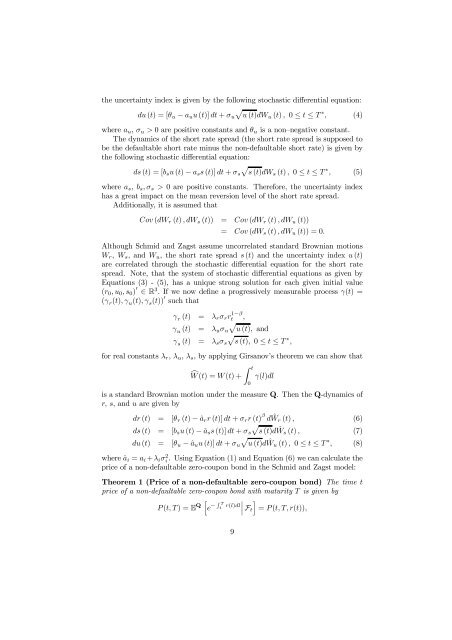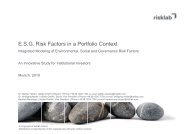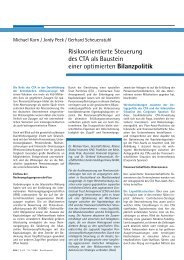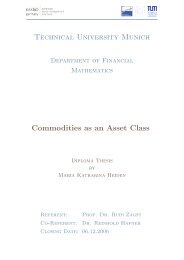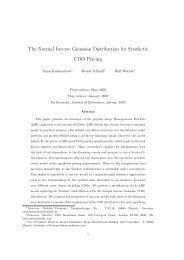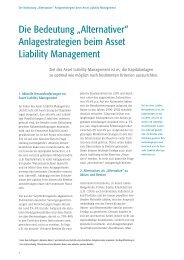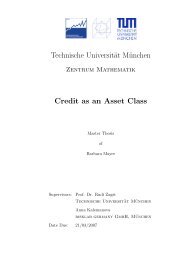Empirical Evaluation of Hybrid Defaultable Bond Pricing ... - risklab
Empirical Evaluation of Hybrid Defaultable Bond Pricing ... - risklab
Empirical Evaluation of Hybrid Defaultable Bond Pricing ... - risklab
Create successful ePaper yourself
Turn your PDF publications into a flip-book with our unique Google optimized e-Paper software.
the uncertainty index is given by the following stochastic differential equation:<br />
du (t) =[θ u − a u u (t)] dt + σ u<br />
p<br />
u (t)dWu (t) , 0 ≤ t ≤ T ∗ , (4)<br />
where a u , σ u > 0 are positive constants and θ u is a non—negative constant.<br />
The dynamics <strong>of</strong> the short rate spread (the short rate spread is supposed to<br />
be the defaultable short rate minus the non-defaultable short rate) is given by<br />
the following stochastic differential equation:<br />
ds (t) =[b s u (t) − a s s (t)] dt + σ s<br />
p<br />
s (t)dWs (t) , 0 ≤ t ≤ T ∗ , (5)<br />
where a s ,b s , σ s > 0 are positive constants. Therefore, the uncertainty index<br />
has a great impact on the mean reversion level <strong>of</strong> the short rate spread.<br />
Additionally, it is assumed that<br />
Cov(dW r (t) ,dW s (t)) = Cov (dW r (t) ,dW u (t))<br />
= Cov (dW s (t) ,dW u (t)) = 0.<br />
Although Schmid and Zagst assume uncorrelated standard Brownian motions<br />
W r , W s , and W u , the short rate spread s (t) and the uncertainty index u (t)<br />
are correlated through the stochastic differential equation for the short rate<br />
spread. Note, that the system <strong>of</strong> stochastic differential equations as given by<br />
Equations (3) - (5), has a unique strong solution for each given initial value<br />
(r 0 ,u 0 ,s 0 ) 0 ∈ R 3 . If we now deÞne a progressively measurable process γ(t) =<br />
(γ r (t), γ u (t), γ s (t)) 0 such that<br />
γ r (t) = λ r σ r r 1−β<br />
t ,<br />
p<br />
γ u (t) = λ u σ u u (t), and<br />
p<br />
γ s (t) = λ s σ s s (t), 0 ≤ t ≤ T ∗ ,<br />
for real constants λ r , λ u , λ s , by applying Girsanov’s theorem we can show that<br />
cW (t) =W (t)+<br />
Z t<br />
0<br />
γ(l)dl<br />
is a standard Brownian motion under the measure Q. Then the Q-dynamics <strong>of</strong><br />
r, s, and u are given by<br />
dr (t) = [θ r (t) − â r r (t)] dt + σ r r (t) β dŴ r (t) , (6)<br />
p<br />
ds (t) = [b s u (t) − â s s (t)] dt + σ s s (t)dŴs (t) , (7)<br />
p<br />
du (t) = [θ u − â u u (t)] dt + σ u u (t)d Ŵ u (t) , 0 ≤ t ≤ T ∗ , (8)<br />
where â i = a i +λ i σ 2 i . Using Equation (1) and Equation (6) we can calculate the<br />
price <strong>of</strong> a non-defaultable zero-coupon bond in the Schmid and Zagst model:<br />
Theorem 1 (Price <strong>of</strong> a non-defaultable zero-coupon bond) The time t<br />
price <strong>of</strong> a non-defaultable zero-coupon bond with maturity T is given by<br />
P (t, T )=E Q h e − R T<br />
t r(l)dl¯¯¯ Ft<br />
i<br />
= P (t, T, r(t)),<br />
9


